Sitka National Historical Park
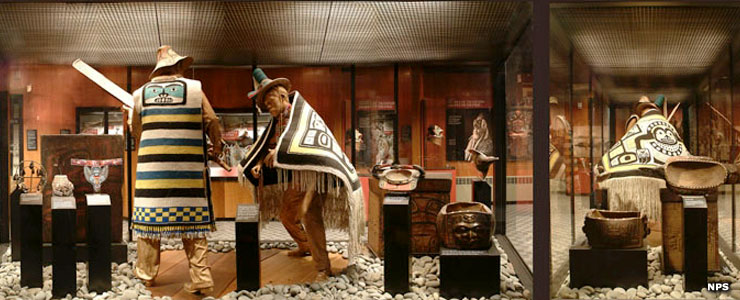
A Tlingit exhibit
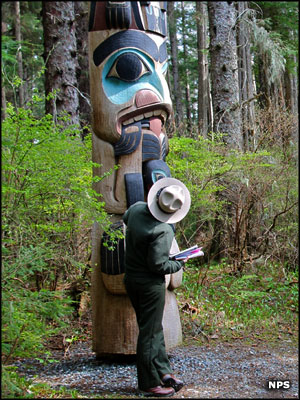
Amid towering spruce and hemlock, Sitka National Historical Park preserves and protects the site of an 1804 battle where the indigenous Kiks.adi Clan of the Tlingit tried to fight off Russian invaders. The property is Alaska's oldest federal park, established in 1890. The park became a National Monument in 1910 and a National Historical Park in 1972. All that is left of the battlefield of the last major battle fought between Northwest natives and European invaders is a clearing at the site where the Tlingit fort once stood. However, Sitka itself contains several examples of Russian colonial architecture, a primary of which is the Russian Bishop's House, a log structure built in 1843 that now sports refurbished living quarters, a series of exhibits of Russian colonial life in Alaska and the Chapel of the Anunciation. The Russians governed Alaska from 1791 to 1867, first from an outpost on Kodiak Island, then from Novo Archangelsk (now known as Sitka).
Russian Alaska was dominated by the Russian American Company which had received its operating charter from the Czarist government. The settlers, though, came from places like Finland, Baltic Germany, Siberia, Russia, Latvia, Estonia, Lithuania, Sweden, Denmark and several other places across Eastern Europe and Central Asia. The native were members of the Tlingit, Alutiq, Creole, Aleut and Haida cultures.
The actual Battle of Sitka was several years in the making. The Tlingit had been there for centuries, living in a village they knew as "Shee Atika." Their cultural was mostly based on their ability to wrest a living from the sea but they also traveled far to the east and often traded furs, shells and other goods with the Athabaskan tribes in the interior of Canada. The Russians were attracted by the bountiful supply of furs they saw. As the Tlingit had recently been exposed to sugar, tobacco and firearms at that time, the Russians could have made excellent trading partners. But the Russians were interested in more than just furs, they wanted free labor and allegiance to the Czar. That didn't go over well with the natives who'd long been self-reliant and didn't appreciate anyone meddling in their lives. That led to an attack on a Russian outpost named Redoubt Saint Michael and the Tlingit killed nearly all the Russians and their Aleut allies at the settlement.

Looking north on Indian River Estuary
That happened in 1802 and the Russians returned in 1804, demanding the Tlingit surrender their village. The Tlingit responded by withdrawing into a fort they'd built just east of their village. On October 1, 1804, four Russian Navy ships proceeded to shell the fort but did little damage. Then they sent troops ashore. The Russian soldiers and Aleut warriors were easily repulsed. Then began a six-day siege of the fort. During the night after the sixth day of fighting, the Tlingit quietly abandoned the fort and disappeared into the forest. The Russians immediately razed the village and built a fortified town on the spot. That town they named Novo Archangelsk and it became the official capital of Russian Alaska in 1808.
It was a Finnish officer in the Russian Imperial Navy, Arvid Adolph Etholen, who spent almost 30 years (from 1817 to 1845) in Novo Archangelsk building up the colony and trying to improve the lives of the Czar's American subjects. Eventually, he became governor of the colony and oversaw the construction of the Bishop's House, the Clubhouse, the Finnish Evangelical Lutheran Church and the beginning of the construction of St. Michael's Cathedral.
The Tlingit were invited back to Sitka in 1821 and they lived in a village just outside the stockaded town until after the Russians turned Alaska over to the Americans and left in 1867. The whole time, the Russians kept their cannons trained on the village and guarded their stockade closely. However, during that time the Tlingits supplied the Russians with plenty of fur and food while the Russians converted them to Christianity and educated them. But as much as the 1804 battle was the end to open Tlingit resistance, the Russians were safe only so long as they kept good guard.
Eventually, the stocks of luxurious furs got depleted by the years of over-hunting and Sitka came to depend on its sawmills, shipyard, fish saltery and ice-exporting business to stay alive. By then, the Czarist government was losing interest and decided to sell. So the Americans ponied up $7.2 million and became the new landlords in 1867.
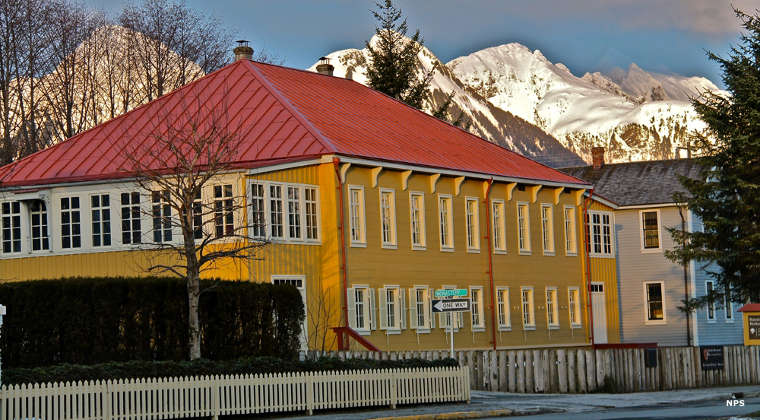
The Russian Bishop's House
In 1890, a panel of three local commissioners appointed to identify lands that should be set aside for public use recommended that the park area around the old community be set aside as a federal public park. President Benjamin Harrison approved that recommendation later that same year. Ten years later, a group of influential Sitka residents began a movement to make the park a national monument and provide a greater level of care and protection to the property. That movement culminated in the Sitka National Monument designation received on March 23, 1910. That proclamation cited the need to commemorate and preserve the battle site from 1804 and protect a newly-installed collection of historic totem poles on the property. The property passed into the care of the National Park Service when that agency was created in 1916 but the Park Service changed nothing until 1921: it was managed from afar and functioned more like a community park than a federal park until it was occupied by military forces in 1942.
The property was returned to the Department of the Interior in 1947, after the military had removed massive amounts of gavel from the park's shoreline, river and estuary. That created environmental problems that are still being wrestled with. A visitor center was finally built in 1965 and it provided room for exhibits and demonstrations of Alaska Native arts and crafts. An agreement was signed in 1969 with the Alaska Native Brotherhood that allowed them to take over and control the demonstration program. Since then, they have operated what is arguably the most successful such demonstration program in the National Park System. The visitor center also offers displays of some remarkable Tlingit artifacts, many of which were loaned or donated to the program under agreements that ensure the clans ongoing traditional use of those artifacts.

Looking south from the park beach
In 1972, the park name was changed to Sitka National Historical Park and the boundaries of the property expanded to include the Russian Bishop's House (which is about 1/2 mile from the main body of the park).
Sitka National Historical Park is comprised of some 113 acres located near the mouth of the Indian River on the western coast of Baranof Island. Among the rugged islands of the Alaska panhandle, Baranof is one of the most rugged with many high peaks and several high altitude glaciers. The lower elevations generally see moderate temperatures year round and are vegetated with what can only be termed a temperate rainforest: western hemlock/Sitka Spruce with a heavy closed canopy. Life in the marine intertidal area is very diverse and unusually productive. From mid-July through September the Indian River is filled with migrating pink and chum salmon. The waters also support chinook and coho salmon, steelhead trout and Dolly Varden char. Spring and fall see lots of migrating waterfowl and shorebirds passing through.
Sitka National Historical Park is also justly famous for the quantity and quality of its totem pole display... Many of the totem poles on display these days are replicas of originals that were placed along the park's pathways back in 1906.
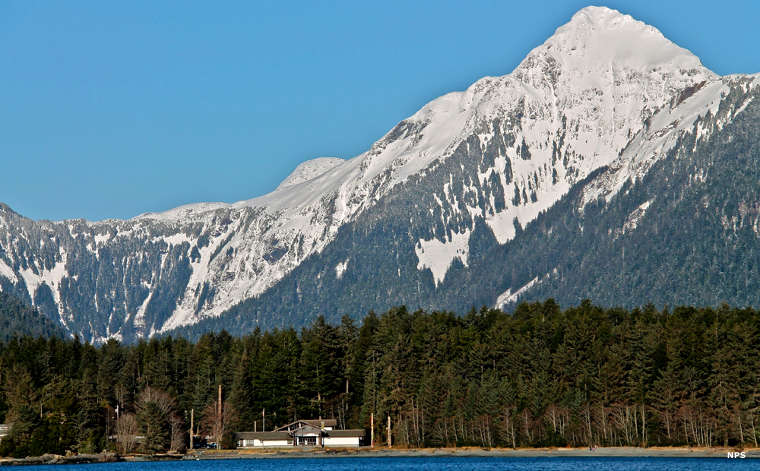
General location of the Sitka National Historical Park Visitor Center
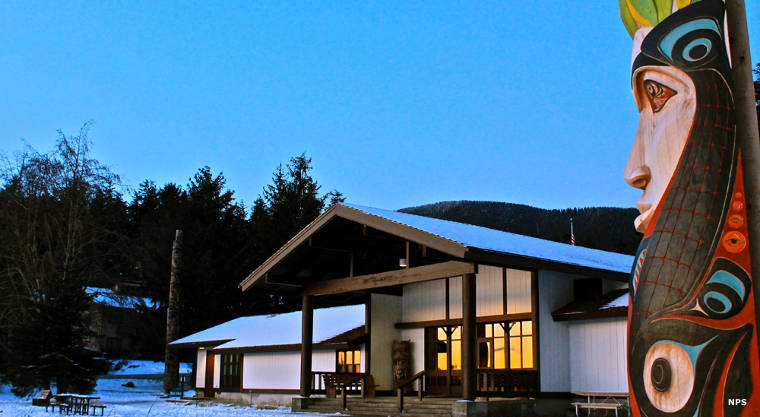
The Visitor Center at sunset